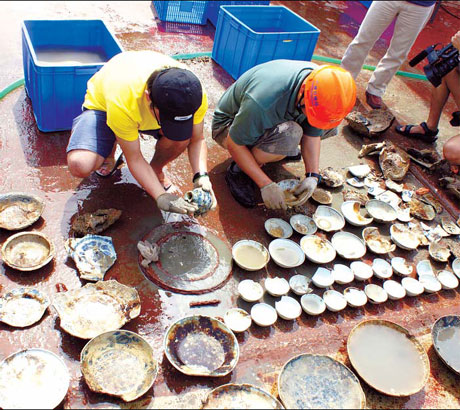Ancient ship may have been used to smuggle arms
The sunken ancient merchant ship Nan'ao No 1, which is being salvaged off Shantou in South China's Guangdong Province, may have been involved in arms smuggling before it sunk.
Piles of copper plates, some of them 60 cm in diameter, and copper coins were found on the vessel. There was a prohibition on exporting copper during the period of the ship's operation in the late Ming Dynasty (AD 1368-1644), Guangzhou Daily reported on Sunday.
"Even if they were not smuggled, they were carried secretly. The ban on the exportation of copper was actually exerted as early as the Song Dynasty (AD 960-1279) and became stricter under the Ming Dynasty Emperor Wan Li," Sun Jian, director of the salvage team from the National Underwater Cultural Heritage Protection Center, was quoted as saying.
|
 |
|
Archaeologists clean up relics on Saturday from Nan'ao No 1, a ship submerged under water off Shantou in South China's Guangdong province. Fang Ganming / Xinhua |
Archaeologists have yet to determine whether the copper plates are finished products or raw material, because they became joined together after spending hundreds of years under water, Sun said. Whichever the case may be, it was highly profitable to export copper at the time, he said.
In the Ming Dynasty, the standard currency system was silver, which could be exchanged for a large amount of copper.
Copper guns and canons were also discovered on the sunken ship. This was not uncommon on ocean-faring merchant vessels at the time, Sun said. Nearly 1,000 relics have been found on Nan'ao No 1 since salvage work resumed last month after a six-month suspension due to unfavorable weather conditions.
Many of the recovered relics are porcelain and metal ware, most of which were made in Zhangzhou of East China's Fujian Province, though some are from the prestigious porcelain town of Jingdezhen in Jiangxi Province.
The relics from the vessel are valuable for the study of ancient porcelain production technologies, the country's ocean trade during that period and the Marine Silk Road - China's southern passage to the outside world, archaeologists said.
The salvage team is still working out a plan to hoist the vessel from the water. The team does not foresee being able to achieve this goal in 2010 due to the unstable weather in the autumn and serious damage to the wooden hull, Sun said.
In 2007, another ancient vessel, Nanhai No 1, was successfully lifted intact from the sea near Yangjiang in Guangdong. These items are on exhibit to the public at the Guandong Marine Silk Road Museum, which opened last December.
Archaeologists have estimated that the South China Sea, the starting point of the Marine Silk Road , may hold more than 1,000 sunken ancient vessels, which, experts believe, indicates that Guangdong has been a commercial hub since ancient times.
 0
0 







Go to Forum >>0 Comments